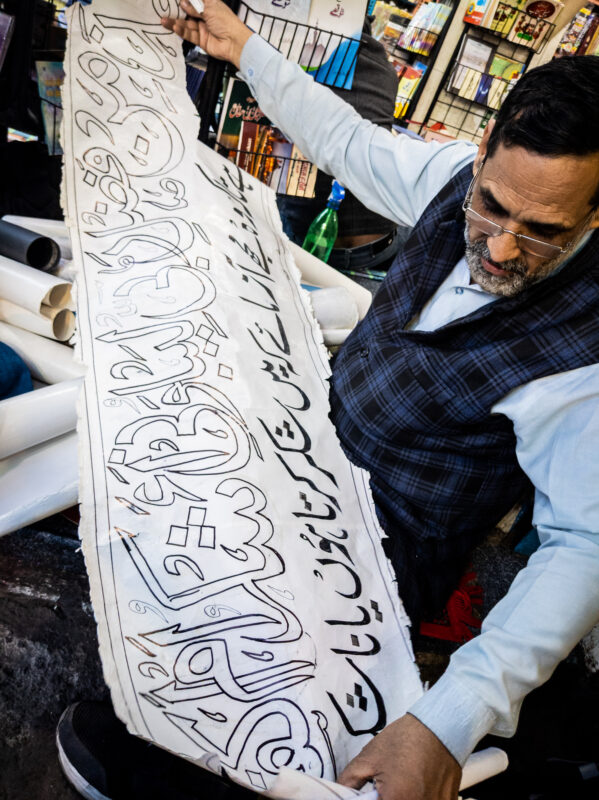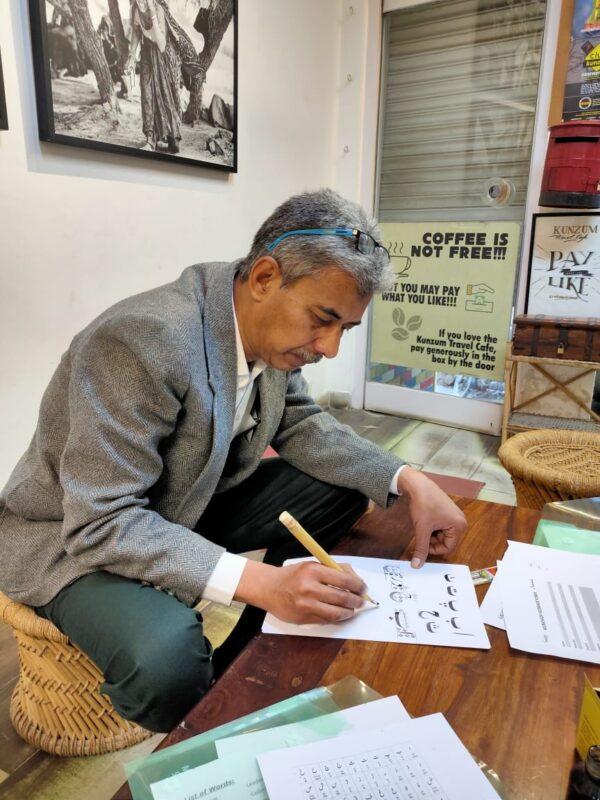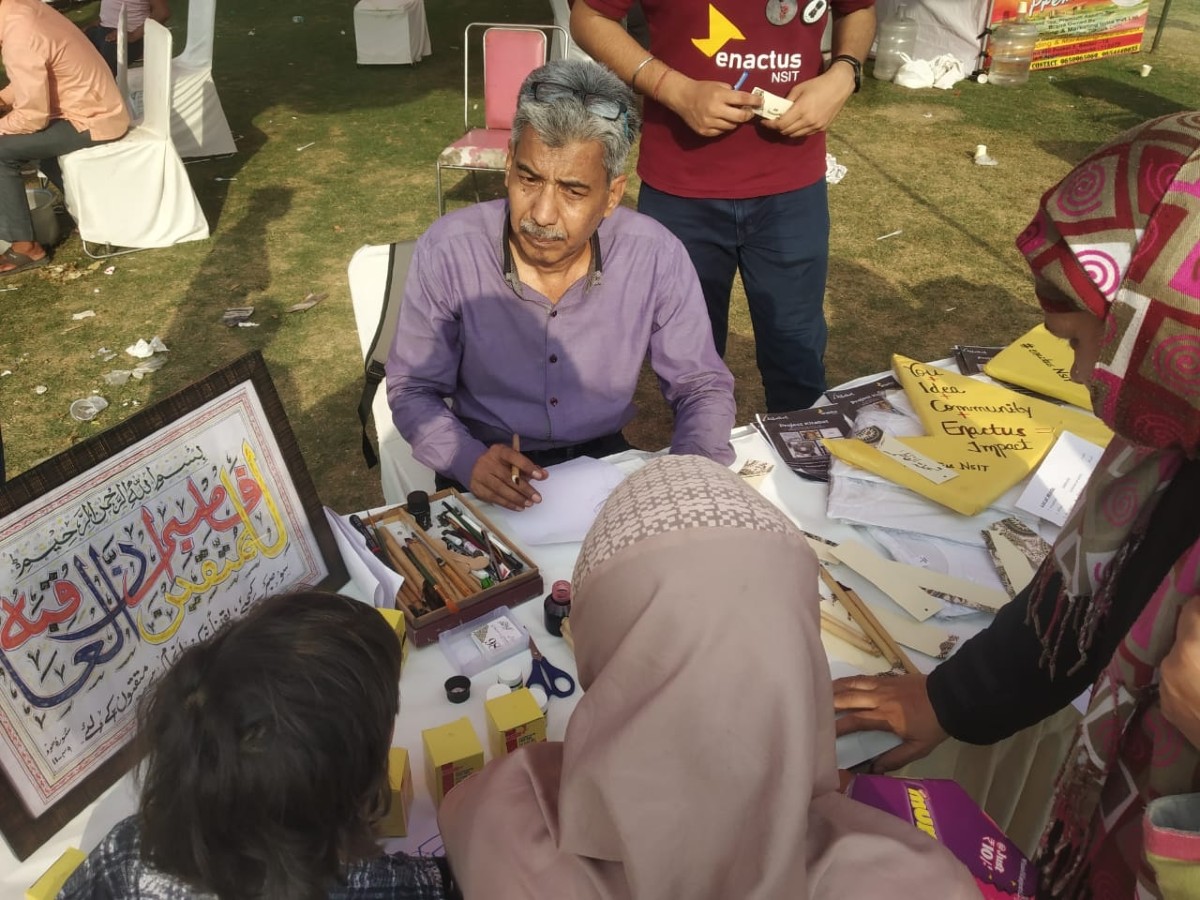Visiting the walled city is like stepping into Delhi’s storeyed past. Among the many things that takes one tothe days of yore is calligraphy.
Sitting in one corner of Kutub Khana Anjuman E Taraqqi E Urdu – a bookstore opposite Jama Masjid — is Mohammad Ghalib “Kaatib“. As he settles down, he takes out his paraphernalia (a bunch of wooden dip pens banded together with elastic, a set of ink — black, white and red — and a small box containing other tools).
Ghalib, 60, hails from Saharanpur and is one of the last known kaatibs (calligrapher) in old Delhi.
“Once a rich art form, kitaabat or calligraphy is no longer that booming a profession. I used to write wedding invitations, books, love letters and shayari (poetry). It was a good phase but digitisation changed things drastically. Now, I don’t have many people coming in and excitedly discussing their books,” he says.
However, Ghalib does get some offer of work from people who still prefer handwritten invitation and calligraphic titles on books. But the income is less. He charges according to the kind of work — depending on the letters — and the time he would require to write. His charges range from Rs 200 to Rs 1000.

Ghalib’s children run a garment shop in neighbouring Chandni Chowk and keep pushing him to join them, but his heart lies in calligraphy.
Struggle and no recognition
Syed Salahuddin, whose father and teacher Syed Manzoor was a renowned name in the field, says, “I have two sons and a daughter and I have taught calligraphy to none of them. But they do the calligraphy more beautifully than I do. You see when computers arrived and digitisation happened, kaatibs or calligraphers were affected severely. Before digitisation, people used to wait for months and even years for the kaatibs to write books on various subjects, including shayari (poetry) or afsaane (stories). But when they realised that computer can do the work faster and cheaper, they switched to it. That is when our once blooming profession died.”
Salahuddin’s father Manzoor had calligraphed around 600 books on history, literature, prose, poetry and religion in Urdu, Arabic, Persian, Sindhi, Pashto and Kashmiri. His works have been distributed in Bahrain, Sharjah, Dubai, Pakistan, Iran and Turkey.
Salahuddin claims that he has raised the matter of struggles of calligraphers several times but their plight hasn’t improved.
“Unfortunately, there is no recognition in the form of any award for such an art,” reasons Salahuddin.
“We live in an age when nearly everything is promoted. The government has not been kind to us. They didn’t recognise our potential. Most of the awards instituted by one organisation or the other, have now been withdrawn,” he laments.
He recalls that the Information and Broadcasting Unit of Press Trust of India (PTI) had a national award for printers and designers. It included one for calligraphers also. However, the authority withdrew this award in 1988.
“The Ghalib Institute too had an award for the same. But this award was also withdrawn 15 years ago. When the government is not supporting us, how will we survive. I live a struggling life and all I have is stories to tell. While there are only a handful of kaatibs left in purani Dilli, people who were solely dependent on this work are now helpless. They now sit on pavements in the vicinity of Jama Masjid and get only a measly amount for their labour of love,” he says.
Salahuddin notes that the art of calligraphy is suffering because it is not being promoted.
“Why would people learn the art when there’s no demand? A few years ago, the Urdu Kitab Mela was organised by the Ministry of Human Resource and Development at Lal Qila ground. It was an 11-day fete focussed on calligraphy and calligraphic books, but shockingly, the organisers couldn’t even recover the rent of the ground, which was Rs 3,000 a day. Only a few people came, and even for them a sum of Rs 25 was too high for getting their names written in calligraphic style. Can you imagine that the famous Rajshri Productions bargained for a rare pen, used in the art, and managed to buy it for just Rs 3,” recalled Syed Salahuddin.
Need to change with times
Abu Sufian, founder Purani Dilli Walon Ki Baatein (a page on social media dedicated to the history of the walled city) observed that it is the need of the hour to revive calligraphy. Having grown up in the walled city, Sufian observed that the reason behind the decline of calligraphy is that the kaatibs don’t want to switch to a more developed form via digitisation.
“People get fascinated by everything in purani Dilli and when they come to see the calligraphers, they come across only a handful of them. People assume that the art has faded but there’s nothing that is ‘last’ in purani Dilli. The only thing is that if the kaatibs would have been a little flexible with the approach we would have been looking at them as teaching in universities and making artwork,and maybe selling them.”
In 2016, Sufian got in touch with a calligrapher and noticed that their reach is only to the masses and not the rich section of the society, who can buy their works of calligraphy.

Sufian also told him to make calligraphy pieces, which he further framed and started putting out in exhibitions and events like Jashn-e-Rehta. The younger generation got fascinated by the work and calligraphy once again started to get noticed.
Similarly, an initiative launched in 2018 by students of the Netaji Subhash University of Technology (NSUT) in Delhi launched ‘Project Kitabat’ in collaboration with Enactus, a US-based non-profit organisation.
Extending a helping hand
Aniket Burman, one of the founding members of the initiative, says, “We connected with a bunch of calligraphers, who are still practising their art in the Capital and facilitated live demonstration workshops at corporate venues. Furthermore, we tried to channelise their talent into creating products like key-chains, tee-shirts and accessories for a new customer base, especially the younger generation. It is sad to see how quickly we have forgotten the existence of kaatibs. When malls came, we thought who will go to nearby markets but people still go to weekly markets. So, why have our calligraphers vanished from the scene after computers arrived? It is because nobody helped them to walk with the changing times. They need help from tech generation to thrive once again. Project Kitabat is just a step.”
Divyam, founder of Humans of Delhi (a blog page featuring humans of Delhi as they navigate through daily life), like Sufian, noticed the declining artform when he went to meet Ghalib at his workplace.
He says, “Sometime back, I went to the Urdu bazaar and met Mr Ghalib. My sister had come from overseas and she wanted to design a book cover. When we approached Mr Ghalib, we discovered that this is such a beautiful artform that actually never died.It neverwill. I decided to put up a post about our interaction on my page, so that everyone notices the presence of calligraphy and helpsto reviveit.”
Fariha Tasnim, a young calligrapher from Delhi shares, “When I was in second year, I enrolled in a certificate course in calligraphy at Jamia Millia Islamia, Delhi. I wanted to learn the craft as my brother believes that calligraphy is an art that requires discipline. I met with a bunch of calligraphers who are quietly living a poor life. I believe that, we as young generation, need calligraphers [as guide] because it is not an artform that one can master on his own.”





